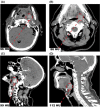Tumor phantom for training and research in transoral surgery
- PMID: 32864438
- PMCID: PMC7444757
- DOI: 10.1002/lio2.426
Tumor phantom for training and research in transoral surgery
Abstract
Objective: With the paradigm shift towards minimally invasive surgical techniques such as transoral laser microsurgery and transoral robotic surgery for resection of head and neck malignancies, there is a need to enhance the surgical training of these techniques as well as provide a platform for testing new approaches and technologies. The steeper learning curve associated with minimally invasive surgical techniques may be mitigated with the use of tumor phantoms (TP) placed in cadaver models.
Methods: An injectable TP was developed using an agar-gelatin base, unsalted chicken stock, deionized water, food coloring for visual mimicry, and iohexol for radiographic mimicry. Four percentage glutaraldehyde was used as a cross-linking agent for solidification of the TP. The TP was then injected in various mucosal anatomic sites in four unfixed cadaver heads. Visual, radiographic, and tactile mimicry was assessed via endoscopy, CT scan, and tumor dissection and palpation, respectively.
Results: Tumor phantom injection was successfully achieved in all four cadaver heads. Visually and tactilely, the TP demonstrated similar color change, induration, and firmness of a typical squamous cell carcinoma (SCCa). However, ulceration that is often seen with SCCa could not be replicated. CT mimicry was compared with nine patients with known SCCa. Tumor radiodensity in the nine patients was between 77 and 110 HU (mean 86.3 HU) whereas TP radiodensity was 59 and 127 HU (mean 93.7 HU), with no significant difference between groups (P = .21).
Conclusion: This inexpensive, easy to apply, and unique tumor phantom could be used both to train transoral techniques and as a tool to further investigate new approaches and technologies for transoral surgery.
Level of evidence: NA.
Keywords: TLM; TORS; cadaver; surgical training; transoral surgery; tumor phantom.
© 2020 The Authors. Laryngoscope Investigative Otolaryngology published by Wiley Periodicals LLC. on behalf of The Triological Society.
Conflict of interest statement
The authors report no conflicts of interest.
Figures




References
Grants and funding
LinkOut - more resources
Full Text Sources
Research Materials
